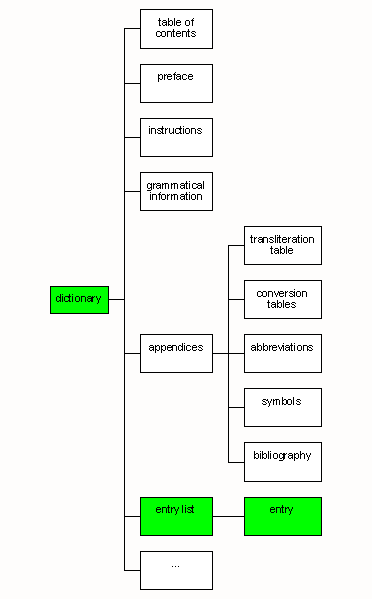The present section focuses on a general dictionary.
A dictionary is structured at three levels below the level of the dictionary as a whole:
The structure of a dictionary is visualized as follows:

The green components of the structure are central to the idea of a dictionary. Dictionaries may be classified on the basis of their macrostructure and their microstructure. These components are treated in separate sections. The other components are dealt with here below.
The table of contents of a dictionary contains the main sections as enumerated in the schema above and discussed here below.
The preface of a dictionary provides at least the following kinds of information:
The metalexicographic notes (a - c) may as well be taken out of the preface and put into a separate section, the introduction.
The user's guide deals with the following topics:
The manner in which this information is presented is naturally tuned to the user group envisaged. Hints for colleagues of the same specialty may be terse; explanations for laymen will make less presuppositions.
As explained elsewhere, a grammar and a dictionary together account for the significative system of a language. Naturally, often only one is produced without the other. Just as many grammars contain a glossary of the vocabulary of the language as an appendix, many dictionaries that lack a grammar companion contain a grammar sketch as a section.
The section on grammatical information may be an entire grammar in a nutshell, which is sometimes called a dictionary grammar. For well-described languages, it more customarily is restricted to a set of inflection paradigms. It is then organized by inflection classes. For each inflection class, an example word is inflected through the paradigm, commonly in the form of a table. The inflection classes are labeled by abbreviations which are referenced in the grammatical section of dictionary entries.
In a plurilingual dictionary, a language may use a non-Latin script. For a syllabic or alphabetic script, a transliteration table may be provided.
For an encyclopedia and a bilingual dictionary, conversion tables for units of measure may be provided.
The entry list of a dictionary with its macrostructure and microstructure fulfills all the usual requirements for the use of abbreviations: standardized categorizations that repeat themselves in thousands of entries need not and should not be spelt out in full, but be abbreviated. The full list of abbreviations used is contained in the present section. Its layout conveniently takes the form of a table. This has at least two columns:
| abbreviation | full form |
|---|---|
| adj. | adjective |
| ... | ... |
Where the terminology is specialized and variegated, a third column may be necessary that hints at the meaning of the term, e.g.:
| abbreviation | full form | explication |
|---|---|---|
| abs. | absolute | free non-incorporated form of noun |
| act. | active | case or cross-reference position in active system |
| ... | ... | ... |
The abbreviation table may again be printed in two columns per page, as is commonly done with the entry-list itself.
Instead of abbreviations, the dictionary may make use of symbols. These are explained like abbreviations:
| symbol | meaning |
|---|---|
| ~ | [copy of lemma] |
| ☞ | see |
| ♀ | female |
| ... | ... |
Just like any piece of intellectual work, a dictionary profits from use of specialized literature, whose bibliographical references are enumerated here.
If the data that the dictionary is based on are a corpus of published texts, then the bibliography should be divided into two subsections: 1) primary sources [i.e. the corpus], 2) specialized literature.
Like other scientific publications, many dictionaries have an index (German Register), i.e. an alphabetical list of expressions of a certain category, each provided with a reference either to a page number or to a dictionary article. Naturally, the entries of the index are not coextensive with the set of lemmas of the entry list. The necessity of such an index arises in a variety of circumstances:
There may also be separate encyclopedic subsections in a dictionary, which may be interspersed with the entry list.
The various main sections of the framing structure complement each other. Certain pieces of information may in principle go in one section or another, and then a principled solution has to be found. For instance:
As explained in the corresponding section, the relational character of most lexical information is part of its essence. It is therefore appropriate that a dictionary contain large quantities of cross-references and of references that lead out of it, and that it be extensively referred to by other components of the language description.
References may be classified as follows:
References of type #2 are treated in the section on the microstructure. References of types #3 and #4 are treated in the section of the place of the dictionary in a comprehensive language description.